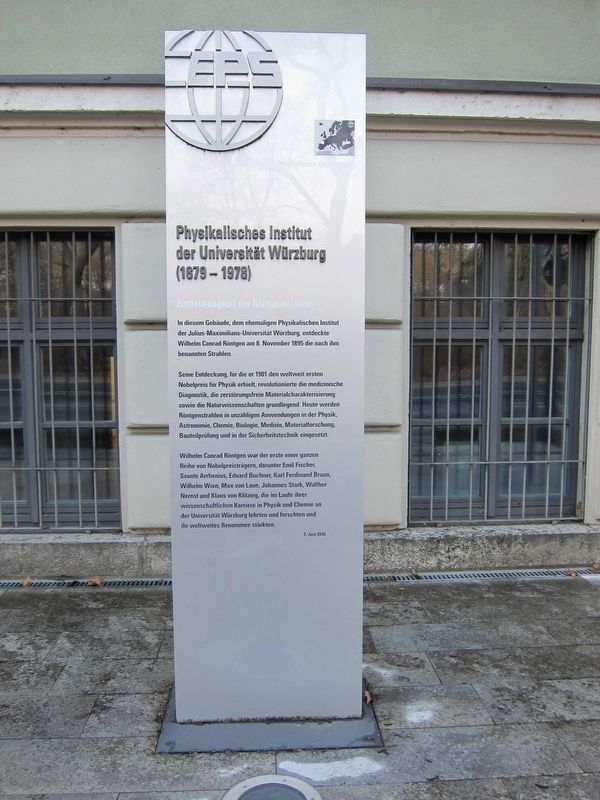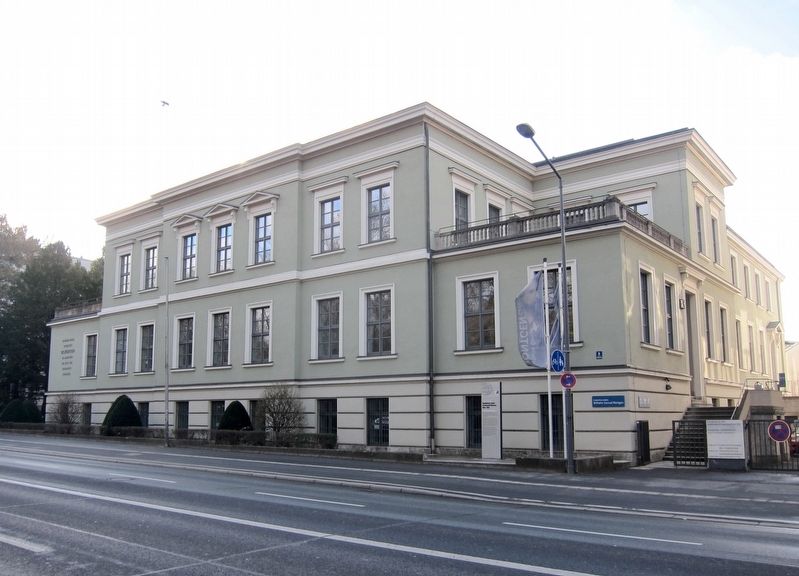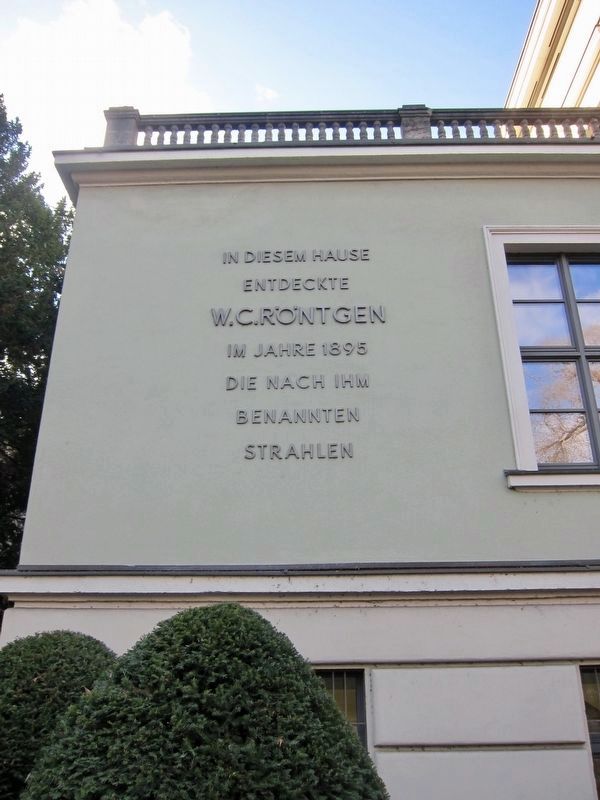Entdeckungsort der Röntgenstrahlen / Site of the Discovery of X-Rays
In diesem Gebäude, dem ehemaligen Physikalischen Institut der Julius-Maximilians-Universität Würzburg, entdeckte Wilhelm Conrad Röntgen am 8. November 1895 die nach ihm benannten Strahlen.
Seine Entdeckung, für die er 1901 den weltweit ersten Nobelpreis für Physik erhielt, revolutionierte die medizinische Diagnostik, die zerstörungsfreie Materialcharakterisierung sowie die Naturwissenschaften grundlegend. Heute werden Röntgenstrahlen in unzähligen Anwendungen in der Physik, Astronomie, Chemie, Biologie, Medizin, Materialforschung, Bauteilprüfung und in der Sicherheitstechnik eingesetzt.
Wilhelm Conrad Röntgen war der erste einer ganzen Reihe von Nobelpreisträgern, darunter Emil Fischer, Svante Arrhenius, Eduard Buchner, Karl Ferdinand Braun, Wilhelm Wien, Max von Laue, Johannes Stark, Walther Nernst und Klaus von Klitzing, die im Laufe ihrer wissenschaftlichen Karriere in Physik und Chemie an der Universität Würzburg lehrten und forschten und ihr weltweites Renommee stärkten.
-
Physics
In this building, the former Physical Institute of the Julius-Maximilians-Universität Würzburg, Wilhelm Conrad Röntgen discovered on November 8, 1895, the rays named after him.
His discovery, for which in 1901 he received the world's first
Nobel Prize for Physics, revolutionized the foundation of medical
diagnostics and the non-destructive characterization of matter,
as well as the natural sciences overall. Today
X-rays are used in countless applications in physics,
astronomy, chemistry, biology, medicine, materials science,
component testing, and safety technology.
Wilhelm Conrad Röntgen was the first of a whole
series of Nobel Prize winners, including Emil Fischer,
Svante Arrhenius, Eduard Buchner, Karl Ferdinand Braun,
Wilhelm Wien, Max von Laue, Johannes Stark, Walther
Nernst and Klaus von Klitzing, who in the course of their
scientific career taught and researched physics and chemistry
at the University of Würzburg, and in doing so
increased their reputation worldwide.
Erected 2016.
Topics. This historical marker is listed in this topic list: Science & Medicine. A significant historical date for this entry is November 8, 1895.
Location. 49° 48.005′ N, 9° 55.836′ E. Marker is in Würzburg, Bayern (Bavaria). Marker is on Röntgenring
Other nearby markers. At least 8 other markers are within walking distance of this marker. Kohlrausch, Roentgen, and Wien (a few steps from this marker); Adolf Eugen Fick (within shouting distance of this marker); Friedrich Wilhelm Scanzoni von Lichtenfels (within shouting distance of this marker); Boris Zarnik, Fritz Richard Baltzer (about 90 meters away, measured in a direct line); Wilhelm Röntgen (about 120 meters away); Eduard Buchner (about 180 meters away); Hermann Müller-Thurgau (about 210 meters away); Historicher Gedenkpunkt / A Place for Historical Contemplation (approx. 0.3 kilometers away). Touch for a list and map of all markers in Würzburg.
Also see . . .
1. University of Würzburg (Wikipedia). "The many medical accomplishments associated with the university from the mid- to late-19th century were inextricably linked with achievements in the affiliated field of natural science, notably by Schwab, the eminent botanist, Semper, the zoologist, Wislicenus, the celebrated chemist and Boveri, the biologist. Their progress culminated in the discovery of x-rays by physicist Wilhelm Conrad Röntgen, first winner of the Nobel Prize for Physics, in 1895. Röntgen's discovery, which he dubbed a
2. About Röntgen (Roentgen-Memorial). The marker stands outside the Roentgen-Memorial, an exhibit of materials related to Roentgen's discovery of X-rays. This website provides a biography of Roentgen, as well as a link to a virtual tour of the memorial site, as well as other related material. (Submitted on June 8, 2019.)
Credits. This page was last revised on January 28, 2022. It was originally submitted on June 7, 2019, by Andrew Ruppenstein of Lamorinda, California. This page has been viewed 118 times since then and 5 times this year. Photos: 1, 2, 3. submitted on June 7, 2019, by Andrew Ruppenstein of Lamorinda, California.


